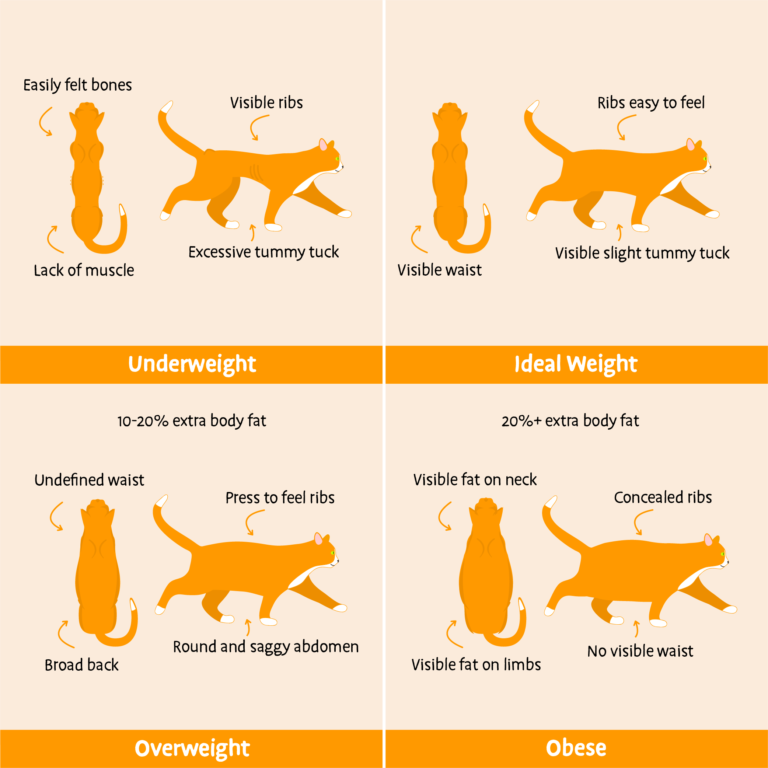Obesity doesn’t just affect humans; our feline friends can also struggle with extra pounds. In this guide, we’ll unpack the complexities of feline obesity, exploring its symptoms, causes, diagnosis, and how to nurse your pudgy kitty back to a healthy weight.
What Is Obesity in Cats?
Feline obesity goes beyond mere chubbiness; it’s an excessive accumulation of body fat that can compromise your cat’s health. Unlike their canine counterparts, cats often hide their weight issues beneath a luxurious fur coat, making it crucial for pet parents to be vigilant.
Symptoms of Obesity in Cats
Identifying obesity in cats involves more than a quick glance. Look out for a lack of a discernible waist, difficulty feeling the ribs, and a rounded appearance. Cats might also show signs of lethargy, unwillingness to engage in physical activities, or even changes in grooming habits.

Causes of Obesity in Cats
Understanding the root causes is pivotal. Diet plays a significant role; overfeeding, high-calorie treats, and lack of portion control contribute to weight gain. Additionally, factors like age, genetics, and a sedentary lifestyle can tip the scales.
Diet-specific Factors
The type and quality of food matter. Cats on a diet predominantly consisting of high-calorie, low-nutrient content are more prone to obesity. Be mindful of treats, as their cumulative impact can lead to unexpected weight gain.
How Vets Diagnose Obesity in Cats
Veterinarians employ a multi-faceted approach to diagnose feline obesity. They assess body condition scores, conduct physical examinations, and may recommend additional tests to rule out underlying health issues. An accurate diagnosis is the first step toward a healthier cat.

Treatment of Obesity in Cats
Once diagnosed, the journey to a healthier weight begins. Vets often recommend a tailored diet plan, portion control, and regulated feeding schedules. Introducing more playtime and engaging your cat in physical activities can also aid weight loss.
Recovery and Prevention of Obesity in Cats
Recovery involves commitment from pet parents. Consistency in feeding practices, providing a balanced diet, and ensuring regular exercise are pivotal. Preventing relapse means staying vigilant, making lifestyle changes permanent, and maintaining regular veterinary check-ups.
Obesity in Cats FAQs
Helping your indoor cat shed those extra pounds involves a combination of diet management and increased physical activity. Consult your veterinarian for a personalized diet plan, consider portion control, and introduce interactive toys or play sessions to encourage exercise.
Identifying when your cat is overweight is crucial. Factors like a lack of a distinct waistline, difficulty feeling the ribs, and a rounded appearance can indicate excess weight. Regular veterinary check-ups and body condition scoring help in determining if your cat has crossed the weight threshold.
Yes, obesity can potentially shorten a cat’s life. It is linked to various health issues such as diabetes, arthritis, and respiratory problems. Additionally, obese cats are more susceptible to complications during surgery or anesthesia. Maintaining a healthy weight is essential for ensuring a longer, happier life for your feline companion.
Yes, certain cat breeds might be predisposed to obesity. Breeds like the British Shorthair, Persian, and Ragdoll are known to have a tendency to gain weight. Understanding your cat’s breed characteristics can help in implementing preventive measures and tailored care to avoid excessive weight gain.
Age can be a contributing factor to feline obesity. As cats age, their metabolism may slow down, and they may become less active. Adjusting their diet and encouraging regular exercise become crucial in preventing age-related weight gain.
In conclusion, feline obesity is a manageable challenge with the right knowledge and commitment. By understanding the causes, recognizing symptoms, and working closely with your veterinarian, you can help your cat achieve and maintain a healthy weight. Remember, a happier and healthier cat is just a few purr-fectly managed meals away!



Pingback: Welcoming a New Cat to Your Home